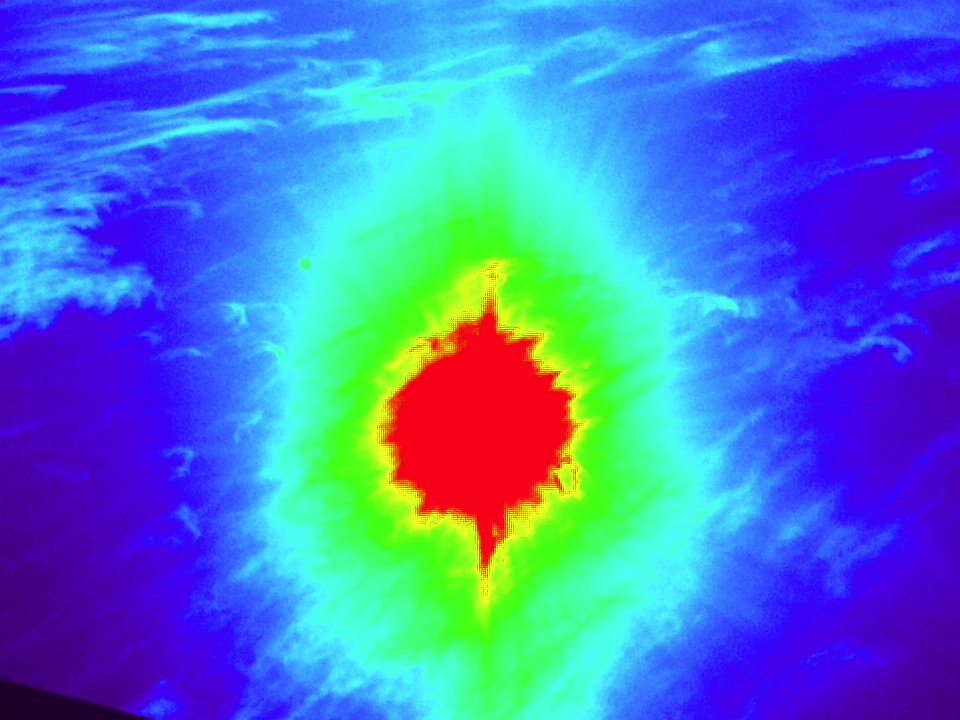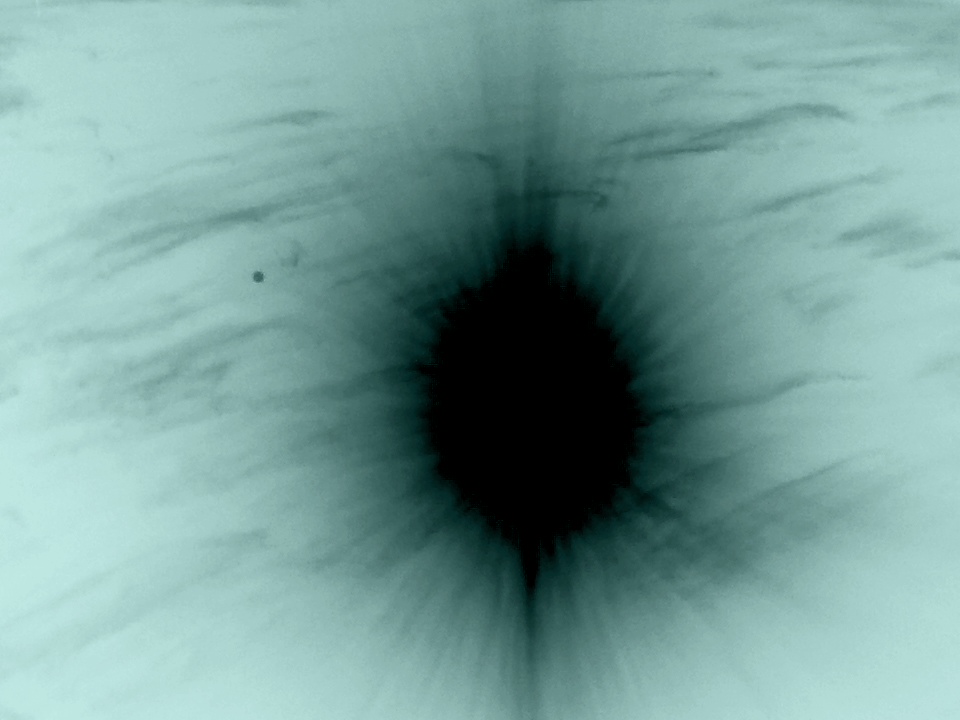Moro em Santos (São Paulo), Brasil, e hoje 15/04 pelas 10h00 tirei uma foto em raios-X do Sol e outra em IV com o meu IPAD. Na foto de raios-X (à direita) consegui observar uma pequena esfera ao lado do sol. Na foto IV (foto da esquerda) a esfera é verde, quase imperceptível. Será algum planeta do nosso Sistema Solar?
A bola que surge ao lado da suposta imagem do Sol não é um planeta do Sistema Solar
(nem qualquer outro objeto celeste). A própria imagem central não é o Sol
(admitindo que as imagens foram realmente obtidas em IV e raios-X).Grande parte da radiação infravermelha (IV) proveniente do Sol é absorvida pelo vapor de água atmosférico. A Astronomia de IV é feita
sempre em zonas altas e muito secas ou então a partir do espaço. Não é provável que se obtenha uma imagem
do Sol saturada como aquela que nos foi apresentada.
O Sol emite raios-x mas a nossa atmosfera, felizmente para a nossa saúde, bloqueia os mesmos a 100%. Mesmo que cheguem alguns
fotões desses cá abaixo não devem ser em número suficiente para formar uma imagem do Sol (muito menos uma imagem saturada como a apresentada).
Toda a Astronomia de raios-X é feita a partir do espaço. Os raios-x
provenientes do Sol são absorvidos nas camadas da atmosfera sendo depois, a sua energia libertada em comprimentos de onda mais altos (visível, IV, rádio..) e menos nocivos. Ao apontar o IPAD para o céu (admitindo que este possui mesmo um detetor de raios-X) devemos obter uma imagem apenas com algum ruído distribuído de forma completamente aleatória.
Os objetos que surgem na imagem apresentada podem resultar, por exemplo, de algum problema interno do equipamento ou de sujidade sobre o detetor. Pode também acontecer que a objetiva estivesse fechada e nesse caso a imagem reflete o ruído interno do equipamento. Nesse caso o ruído pode resultar de fotões com os mais diversos comprimentos de onda (raios-X, visível, IV, rádio,...).
Outro aspeto estranho é o das duas imagens terem, aparentemente, a mesma resolução. Não é normal quando trabalhamos com bandas do espetro tão distintas como são os raios-X e o IV.
A única hipótese plausível de o objeto saturado no centro da imagem ser o Sol é admitir que o detetor trabalha ao mesmo tempo com IV e visível (as câmaras digitais trabalham entre o infravermelho e o ultravioleta). Assim a imagem IV seria uma mistura de radiação visível
com IV.
No caso da imagem de "raios-X" o mais plausível é que seja uma imagem feita
na banda do visível, convertida para tons de cinzento e invertida. A
contribuição de raios-X provenientes do Sol para esta imagem é zero. É apenas
uma imagem feita na banda do visível e depois tratada.
I live in Santos (São Paulo), Brazil, and today, 15/04/2013, at 10:00 am, I took an X-ray photo of the Sun and another one in IR with my IPAD. In the X-ray photo (on the right), I could see a small sphere next to the sun. In IV photo (left), the sphere is green, almost imperceptible. Is it a planet in our Solar System?
The ball that appears next to the supposed image of the Sun is not a planet in the Solar System (or any other celestial object). The central image itself is not the Sun (assuming the images were indeed taken in IR and X-rays).
Much of the infrared (IR) radiation from the Sun is absorbed by atmospheric water vapor. IR Astronomy is always carried out in high and very dry areas or from space. It's unlikely you can obtain a saturated image of the Sun like the one presented to us.
The Sun emits x-rays, but our atmosphere, luckily for our health, blocks them 100%. Even if some of these photons arrived on the surface, they should not be enough to form an image of the Sun, much less a saturated image like the one presented. All X-ray astronomy is done from space. X-rays coming from the Sun are absorbed in the layers of the atmosphere and then their energy is released in higher wavelengths (visible, IR, radio), which are less harmful. By pointing the iPad at the sky, and assuming it does have an X-ray detector, we should get an image with only some noise distributed in a completely random way. The objects that appear in the displayed image may result, for example, from some internal problem in the equipment or from dirt on the detector. It could also happen that the lens was closed and in that case the image reflects the internal noise of the equipment. In this case, the noise can result from photons with any wavelength.
Another strange thing is that the two images apparently have the same resolution. It is not normal when we work with spectrum bands as different as X-rays and IR. The only plausible hypothesis that the saturated object in the center of the image is the Sun is to admit that the detector works with IR and visible at the same time, while digital cameras work between infrared and ultraviolet. Thus, the IR image would be a mixture of visible and IR radiation.
In the case of the "X-ray" image, the most plausible scenario is that it's an image made in the visible band, converted to grayscale and inverted. The contribution of X-rays from the Sun to this image is zero. It's just an image made in the visible band, after being processed.





